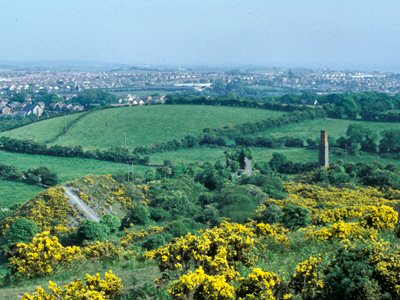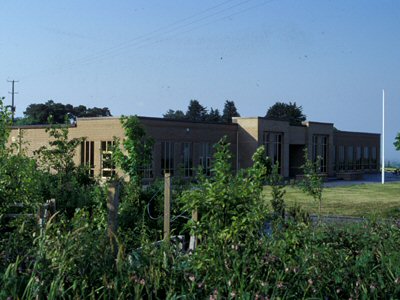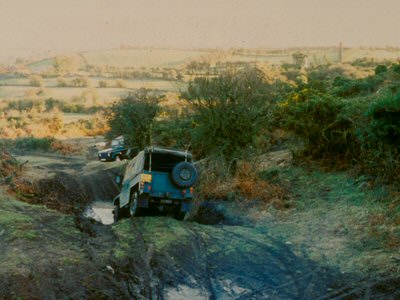Earth Science Conservation Review
| Whitespots - Conlig lead mines | Down |
| Site Type: | Mine (disused), Spoil heaps |
| Site Status: | ASSI |
| Council area: | Ards Borough Council |
| Grid Reference: | J492765 |
| Google maps: | 54.61509,-5.69044 |
| Rocks | |
|---|---|
| Rock Type: | Greywacke, Shale |
| Interest | |
| Minerals: | Barytes, Calcite, Chalcedony, Chalcopyrite, Dolomite, Galena, Harmotome, Pyrite, Sphalerite |
| Other interest: | hydrothermal vein |
Summary of site:
From the late 18th century to 1900 around 13,500 tonnes of lead were produced from the mineral veins of the 10 Conlig mines at Whitespots immediately north of Newtownards. It was the largest mine complex in Ireland at the time and this tonnage makes it one of the most important mining areas in the United Kingdom in the 19th century. All that now remains of this once thriving industry is ruinous buildings, overgrown spoil heaps, tailings (unwanted residues of crushed ore) and capped shafts.
The mines exploited mineralized breccias, angular rock fragments in the crush zone of north/south trending faults, defining a series of anticlines from 1.5 to 3 km north of Newtownards. The breccias are cemented by quartz and dolomite (calcium magnesium carbonate) and the ores occur as coarsely crystalline masses within them. The main ore minerals are galena (lead sulphide), chalcopyrite (copper iron sulphide), pyrite (iron sulphide) and sphalerite (zinc sulphide); the main associated minerals of no economic importance (gangues) are quartz, chalcedony (a finely crystalline variant of quartz), dolomite, calcite (calcium carbonate) and barite (barium sulphate). Also adding to the mineralogical importance of the site are the secondary minerals cerussite (lead carbonate), hydrozincite (zinc carbonate), bornite (copper iron sulphide), malachite (copper carbonate), azurite (another variety of copper carbonate), pyromorphite (phosphatized lead chloride) and harmotome (a barium aluminosilicate), a zeolite mineral. Fine crystalline specimens can still be recovered from the spoil heaps and most species can be found in the collections of the Ulster Museum.
The brecciated host rocks of the area are the slightly metamorphosed mudstones of the Gala Group. They are Silurian in age and were faulted and brecciated in a continental collision, the Caledonian orogeny, towards the end of that period or early in the succeeding Devonian, 420 to 410 million years ago. This first mineralization was quartz dominated and was followed in the late Carboniferous or early Permian by a second orogeny, the Hercynian, the period of the main mineralization. A late and final contribution to the mineral suite is the zeolite, associated with a dolerite dyke, almost certainly intruded in the early Tertiary about 60 million years ago.
4 mineralizations are recognised at Whitespots. The first was the Caledonian, cementing the breccia with milky white quartz. The second, in the early Hercynian, was a low temperature event, somewhere between 50 and 200 degrees centigrade, when mineral-saturated fluids cemented the freshly pulverised host rock with chalcedony. The third, probably a late Hercynian episode, was the main mineralization, when higher temperature mineral-laden brines, between 200 and 300 degrees centigrade, deposited the suite of lead, zinc and copper minerals with barite and dolomite. The final phase, probably early in the Tertiary, was a much lower temperature event (60 to 85 degrees is suggested) lining cavities and open veins with pyrite, calcite and the zeolite mineral, harmotome.
Analysis of fluid inclusions in the main ore minerals indicates a chemical similarity with the major stratified ore deposits in the Carboniferous rocks in the Republic of Ireland.
The site is a designated Area of Special Scientific Interest (ASSI) but without active management deterioration will compromise its scientific and cultural interest. Scrambler bikes have caused serious erosion of the spoils which constitute the major remaining scientific resource and measures should be taken to prevent further damage. The spoils should be isolated and refreshed periodically by turning to expose new material. As Ireland's most important 19th century mining area, a case can also be made for the preservation of the surviving mine buildings on the site, particularly the chimneys at the North and South Engine Houses, the Windmill and the Bog and Conlig Shafts' engine houses. This supremely important element of the industrial, scientific and cultural heritage is unlikely to be repeated on this scale ever again and should not be lost to future generations.
The mines exploited mineralized breccias, angular rock fragments in the crush zone of north/south trending faults, defining a series of anticlines from 1.5 to 3 km north of Newtownards. The breccias are cemented by quartz and dolomite (calcium magnesium carbonate) and the ores occur as coarsely crystalline masses within them. The main ore minerals are galena (lead sulphide), chalcopyrite (copper iron sulphide), pyrite (iron sulphide) and sphalerite (zinc sulphide); the main associated minerals of no economic importance (gangues) are quartz, chalcedony (a finely crystalline variant of quartz), dolomite, calcite (calcium carbonate) and barite (barium sulphate). Also adding to the mineralogical importance of the site are the secondary minerals cerussite (lead carbonate), hydrozincite (zinc carbonate), bornite (copper iron sulphide), malachite (copper carbonate), azurite (another variety of copper carbonate), pyromorphite (phosphatized lead chloride) and harmotome (a barium aluminosilicate), a zeolite mineral. Fine crystalline specimens can still be recovered from the spoil heaps and most species can be found in the collections of the Ulster Museum.
The brecciated host rocks of the area are the slightly metamorphosed mudstones of the Gala Group. They are Silurian in age and were faulted and brecciated in a continental collision, the Caledonian orogeny, towards the end of that period or early in the succeeding Devonian, 420 to 410 million years ago. This first mineralization was quartz dominated and was followed in the late Carboniferous or early Permian by a second orogeny, the Hercynian, the period of the main mineralization. A late and final contribution to the mineral suite is the zeolite, associated with a dolerite dyke, almost certainly intruded in the early Tertiary about 60 million years ago.
4 mineralizations are recognised at Whitespots. The first was the Caledonian, cementing the breccia with milky white quartz. The second, in the early Hercynian, was a low temperature event, somewhere between 50 and 200 degrees centigrade, when mineral-saturated fluids cemented the freshly pulverised host rock with chalcedony. The third, probably a late Hercynian episode, was the main mineralization, when higher temperature mineral-laden brines, between 200 and 300 degrees centigrade, deposited the suite of lead, zinc and copper minerals with barite and dolomite. The final phase, probably early in the Tertiary, was a much lower temperature event (60 to 85 degrees is suggested) lining cavities and open veins with pyrite, calcite and the zeolite mineral, harmotome.
Analysis of fluid inclusions in the main ore minerals indicates a chemical similarity with the major stratified ore deposits in the Carboniferous rocks in the Republic of Ireland.
The site is a designated Area of Special Scientific Interest (ASSI) but without active management deterioration will compromise its scientific and cultural interest. Scrambler bikes have caused serious erosion of the spoils which constitute the major remaining scientific resource and measures should be taken to prevent further damage. The spoils should be isolated and refreshed periodically by turning to expose new material. As Ireland's most important 19th century mining area, a case can also be made for the preservation of the surviving mine buildings on the site, particularly the chimneys at the North and South Engine Houses, the Windmill and the Bog and Conlig Shafts' engine houses. This supremely important element of the industrial, scientific and cultural heritage is unlikely to be repeated on this scale ever again and should not be lost to future generations.
| Enlander, I., Dempster, M. & Doughty, P., 2025. Whitespots - Conlig lead mines, County Down, site summary. [In] Earth Science Conservation Review. https://www.habitas.org.uk/escr/summary.php?item=529. Accessed on 2025-04-03 |
| Previous Site | Next Site |



